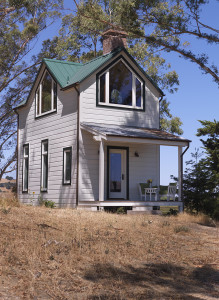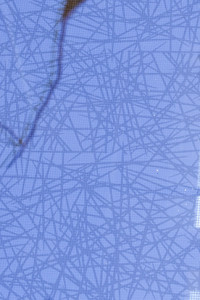It’s pretty rare to pioneer the use of something, and have it actually work. This is one of those stories, attested to by the first-hand experience of two inveterate bird lovers and technophiles with impeccable credentials. Three years ago we completed a project on their Petaluma farm property that included the first West Coast application of Ornilux “Mikado” anti-bird strike glazing – here’s why that is significant.
According to the Audubon Society, a billion birds a year are killed by collisions with windows in the US alone. A small portion of that billion have been victims of the picture window in my clients’ farmhouse retreat on the Petaluma River.  So, when we rebuilt an old farm utility building and added a second story with large view windows on four walls (see photos) there was much angst about the hazard to the many birds that frequent this extensive marsh north of San Francisco Bay. We found a promising solution, a unique glazing product imported from a German glass manufacturer, Arnold Glas.
So, when we rebuilt an old farm utility building and added a second story with large view windows on four walls (see photos) there was much angst about the hazard to the many birds that frequent this extensive marsh north of San Francisco Bay. We found a promising solution, a unique glazing product imported from a German glass manufacturer, Arnold Glas.
Here’s how  it works. A coated pattern on the glass is highly selective for ultraviolet light, which birds’ eyes see and human eyes don’t. The photo shows the pattern (see below for why we can see it in some circumstances), which looks to me like a thicket of brambles, but which the company calls a “Mikado” pattern for reasons that don’t translate well to the North American experience. The inventor of this technology thinks the pattern is like spiders’ webs, and in fact he was inspired by webs because of the phenomenon whereby webs, which have evolved to have high ultraviolet light reflectivity, can be seen by birds well enough to avoid them in high-speed flight. How do we know this invisible thing on the glass works? Because it’s been tested by researchers (see this recent fascinating article in the New York Times). Also because the owners have observed no bird remains or telltale piles of feathers, just 200 feet from the infamous killer picture window in the main house. The great thing about this glass is that you literally see no trace of the pattern looking out the windows. You can only see the pattern in the image of a reflected sky, especially if you stand below or off to the side. The reason for that seems to be that the coating’s effect on reflections spills slightly into the visible light spectrum, especially from oblique points of view. But, take it from me, even seasoned architects have failed to notice this coating until the oblique-viewing effect on sky reflections was pointed out.
it works. A coated pattern on the glass is highly selective for ultraviolet light, which birds’ eyes see and human eyes don’t. The photo shows the pattern (see below for why we can see it in some circumstances), which looks to me like a thicket of brambles, but which the company calls a “Mikado” pattern for reasons that don’t translate well to the North American experience. The inventor of this technology thinks the pattern is like spiders’ webs, and in fact he was inspired by webs because of the phenomenon whereby webs, which have evolved to have high ultraviolet light reflectivity, can be seen by birds well enough to avoid them in high-speed flight. How do we know this invisible thing on the glass works? Because it’s been tested by researchers (see this recent fascinating article in the New York Times). Also because the owners have observed no bird remains or telltale piles of feathers, just 200 feet from the infamous killer picture window in the main house. The great thing about this glass is that you literally see no trace of the pattern looking out the windows. You can only see the pattern in the image of a reflected sky, especially if you stand below or off to the side. The reason for that seems to be that the coating’s effect on reflections spills slightly into the visible light spectrum, especially from oblique points of view. But, take it from me, even seasoned architects have failed to notice this coating until the oblique-viewing effect on sky reflections was pointed out.
Cost? Based on what our custom windows and doors would have cost with conventional energy-conservation dual glazing, the bird glass units increased the cost of the windows around 15% – that despite some adverse economic factors. We had to import the window glass from Germany because it is manufactured nowhere else. The U.S. representative for Arnold handled taking the order, and their execution was flawless, from conveying the dimensions exactly right, to delivering on schedule through customs to our window and door builder. Nothing broken, everything fit.
What’s not to like? There’s a natural human tendency to avoid new things, even if the science is there. Eventually the testimonials will mount, the product will become even better and more affordable, and adoption will happen. For now, clients might be skeptical, and the glass has to be imported and installed in custom windows because mass manufacturers are not going to disrupt their production lines for a glazing type from an outside source – that is, until an architect with a really big project requires it. And did I say that it uses reflected ultraviolet light? That spectrum is in short supply when the sun isn’t shining, so this isn’t going to prevent migrating flocks from striking highrise buildings at night. I wonder if someone is interested in shining blacklight on these windows as an experiment to extend their effectiveness to all hours of the day? [scroll down to add a comment!]
Birds can’t see glass (neither can people, which surprises many). A decal on glass is enough to warn people that a pane of glass is there – we start learning the cues, mostly architectural, that tell us where glass is very early – although people run into glass doors and walls all the time. A decal isn’t enough for birds – they see the decal but they still don’t know what glass is; the decal is an obstacle they could fly around. We can use patterns on glass, like Ornilux, to deter bird collisions – birds see effective patterns as literal barriers, with spaces too small to fly through safely.
When Robins or Cardinals attack glass repeatedly, it is a different situation entirely. These are territorial males that think their own reflection is a rival male. Ornilux and most other collisions solutions still let the bird see his reflection, as though it is a bird still very close by, enough to elicit the aggressive behavior. Luckily for the birds, this behavior doesn’t injure them, but it can irritate people and it does waste a lot of time the bird could spend doing something more productive.
Males with mates usually stop being aggressive as soon as egg laying starts – they don’t want to be conspicuous to predators. A male without a mate, usually a young bird, may keep attacking a window. The simplest solution is just to tape a piece of paper to the outside of the window. You could also smear the glass with dilute Tempera paint, Glass Wax (now called something else, sorry) or a paste of soap and water. Unfortunately, some birds then move on to the next window, and so on. External solar shades are a good option, if this happens every year!
Christine, as a leading author in this area, your comments are very valuable! I wonder what you think of the idea of exploring how a small-wattage UV light emitter directed against the Ornilux glass at night might discourage collisions during the part of the day when natural UV is non-existent? I think it could be a practical idea, and incorporating day and night protection into one product has a great advantage.
Will this solve the problem of the Robin persistently attacking itself in a glass window? In our parts we see this territorial issue with Robins on many glazing types.
Stan, I’ve been wondering that myself, since Robins attack my car windshield pretty often. Since the glass disrupts the reflected image, my guess is that it will discourage the behavior. I’ll ask the owners to report on this question.
I love your comment that “even seasoned architects have failed to notice this coating”. Wonder who you meant by that. Anyway, I definitely want to be included in this blog, but keep in mind that some of us still “in the field” have to deal with clients who are still skeptical of this whole “insulated glass” thing, let alone anything more radical. I recently that to go to some lengths to convince an old client of mine that if we replaced his old single-pane kitchen greenhouse window with an insulated one that the world would not end. On the other hand, it’s heartening to see that LED technology has finally become mainstream. Small steps, and always more to learn.
It is remarkable that the pattern is not visible when you look through the window.